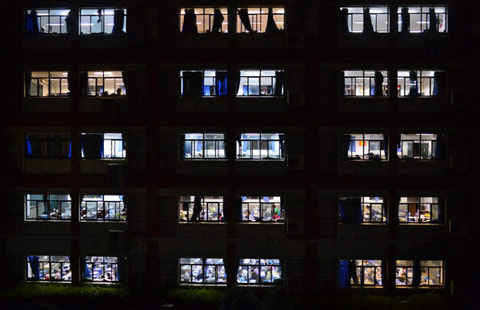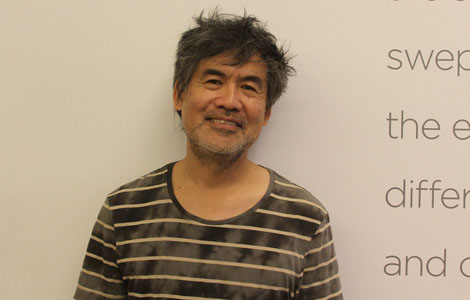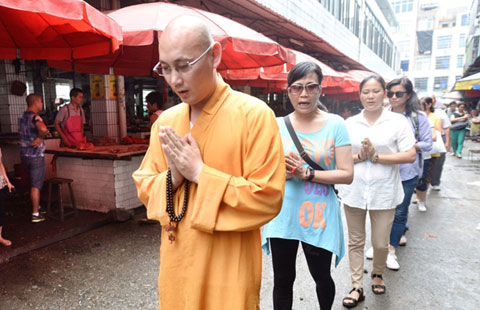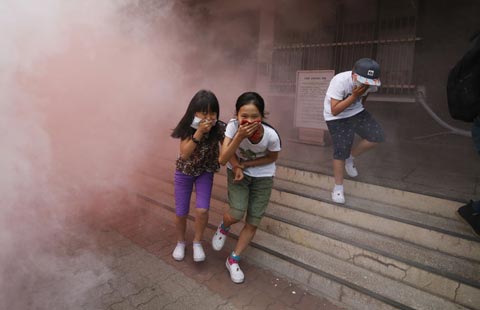Out of the shadows
Updated: 2014-06-24 07:08
By Chen Nan (China Daily)
|
||||||||
Graffiti art was once an underground pursuit, practiced by artists in dark corners of the city, but as Chen Nan reports, the renegade artists are increasingly finding their work more accepted by the mainstream.
In loose jeans, armed with gas mask and a black backpack, Ye Shu walks into the woods next to Jingmi Lu, a road beside Beijing's airport expressway. He glances around making sure no one is watching before taking out the spray cans from his bag. For graffiti artists like Ye, the woods, stretched across 2 kilometers, are a perfect playground.
He will spend hours or even a whole day in these woods, spraying colors on the wall, admiring his work for a few seconds and taking photos of it. Ye, 30, has been doing this for nearly 10 years.
A new generation of urban youth seeking new ways to express themselves has seen graffiti emerge from the underground. Graffiti artists, like Ye, are eager to attract a wider audience to their art.
A tag featuring the Chinese characters, "Za Tou", which is rumored to have been created by a foreigner named Zato, can be seen throughout the city, from store's roller doors to hutong walls.
In May, a large graffiti appeared overnight under the Anzhenqiao Bridge in northern Beijing and received wide attention.
"I love painting there because the walls are hidden behind the woods and unnoticed by police. It's really frustrating to see an unfinished work whitewashed by police," Ye says.
But Ye no longer has to paint on hidden walls. In fact, he is making a living as a graffiti artist.
In 2010, along with the other members of ABS Crew, a graffiti group which Ye founded in 2007, he opened a studio in Beijing's 798 Art Zone, a popular hub showcasing contemporary Chinese art.
Two years later, he opened a store next to the studio, selling products such as spray paint and T-shirts featuring his art.
This summer, Ye will launch a hip-hop summer camp in cooperation with the French embassy in Beijing, presenting various street culture events, like break dancing and graffiti.
"Graffiti has been recognized today, but has a niche market. Even today some people still cannot understand what we are doing," he says.
In 2004, when Ye was a student of art design at a university in Tianjin, he watched Jackie Chan's Rumble in the Bronx. He was fascinated by the graffiti scene and bought a can of spray paint from a hardware store and painted his name on a wall at the university.
"I felt so excited to see my name on the wall because the visual impact was so strong," he recalls. However, his teachers and classmates were less impressed, accusing him of vandalism.
The first public graffiti that Ye's ABS Crew undertook was to spray paint a six-story building in Tianjin. The work was commissioned by the local government for a music themed street outside Tianjin's Conservatory of Music.
Since then, Ye has worked with companies, such as Nike and Audi. Ye now plans to work with Beijing's CBD area to create graffiti art amid office buildings.
He is excited by the news that a section of the Great Wall in the popular tourist destination of Mutianyu has been flagged to become a dedicated graffiti zone.
Zhang Tongcai, an official from the management office of Mutianyu Great Wall, says the intention is to protect the ancient bricks rather than encouraging graffiti, but Ye says he and his team intend to create some art work specifically for the area.
Zhang says 2.8 million tourists visit the Mutianyu Great Wall every year, and 40 percent are foreigners.
"Graffiti has been controversial because the line between art and vandalism is blurred. There is no law on graffiti in China so people feel free to paint wherever they want," says Liu Zheng, a graffiti artist of Kwan Yin Clan, a group founded by Liu in 2006 along with several other young people in Beijing.
Liu, 29, who studied visual design, was a rapper in the university. He created his first graffiti on the walls outside Sihui subway station in Beijing in 2006, which he described as "dropping a bomb".
"I used to paint at night and quickly or I would be stopped by police," Liu recalls.
At first he painted to express himself and to relieve pressure. Now, he says he combines the techniques of traditional Chinese ink painting with graffiti.
Along with members of Kwan Yin Clan, Liu has painted the walls outside Beijing Institute of Technology and Beijing Institute of Fashion Technology, as part of a project commissioned by the government during the 2008 Beijing Olympic Games.
"To me, the attraction of graffiti is the beautiful color and lines. The more I paint, the more I realize that it's about culture and society," Liu says.
"People's attitude toward graffiti has started to change because they can appreciate it in advertising and on TV. It's not something secretive any more."
Contact the writer at chennan@chinadaily.com.cn
(China Daily 06/24/2014 page19)

 Council of Fashion Designers of America Awards
Council of Fashion Designers of America Awards
 Fan Bingbing, first Chinese actress in Barbie Hall of Fame
Fan Bingbing, first Chinese actress in Barbie Hall of Fame
 Awarding ceremony of 2014 hito Pop Music held in Taipei
Awarding ceremony of 2014 hito Pop Music held in Taipei
 Zhao Liying's photo shoot for Children's Day
Zhao Liying's photo shoot for Children's Day
 'Taken 2' grabs movie box office crown
'Taken 2' grabs movie box office crown
 Rihanna's 'Diamonds' tops UK pop chart
Rihanna's 'Diamonds' tops UK pop chart
 Fans get look at vintage Rolling Stones
Fans get look at vintage Rolling Stones
 Celebrities attend Power of Women event
Celebrities attend Power of Women event
Most Viewed
Editor's Picks

|

|

|

|

|

|
Today's Top News
Hundreds held in Xinjiang terror blitz
Putin, Obama discuss Ukraine crisis over phone
Factory output estimate indicates stability
US-China ties get a boost from grassroots
US, not China, key to Peninsula issue
Crackdown urged on Web terror content
Guinness record for plank
Criticism by ex-US official dismissed
US Weekly

|

|








